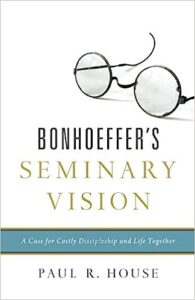Reviewing Bonhoeffer’s Seminary Vision
I have not engaged substantially in the study of Dietrich Bonhoeffer. Most of the celebrity that Bonhoeffer has earned is in the spheres of ethics, piety, and courage (and he rightly merits our admiration on those counts); still, I have been concerned that unqualified celebration of these traits might unwittingly commend as well his theology, which has deep deficiencies. For appropriate warnings in this matter, see, e.g., here and here.
Despite my hesitations, a recent online review persuaded me to purchase and read Paul House’s little book, Bonhoeffer’s Seminary Vision: A Case for Costly Discipleship and Life Together. House’s burden is not hagiographic; rather his goal is to alert his readers to a hole growing in modern seminary studies. House begins by observing that Bonhoeffer did not write his two most celebrated works, The Cost of Discipleship and Life Together, in the crucible of pastoral ministry, but during his years as a seminary director in Nazi Germany. As such, the experience under review in these two volumes is that of a seminary professor and his students. House’s thesis, if I may reconstruct it, is that the modern seminary, with its emphasis on distance education, is in danger of suppressing and even actively avoiding two of its principal tasks, viz., fostering “costly discipleship” and “life together.” The book is largely narrative, but House carefully selects anecdotes to establish his thesis. Specifically, House observes that seminarians in Bonhoeffer’s day did not select their seminary based on many leading considerations offered today: tuition/debt-deferment, flexibility of schedule, and alternatives to physical classrooms (much less attending class in one’s pajamas). Indeed, with Bonhoeffer’s works as our guide, seminarians did precisely the opposite. Fostering costly discipleship and life together were among their chiefest goals.
Bonhoeffer’s Seminary Vision has six chapters. The first two introduce Bonhoeffer’s vision and historical milieu. The next three offer specific insights on “costly discipleship,” “life together,” and “visible, faithful witness” in seminary life. Each chapter closes with practical insights for modern-day “incarnational seminaries.” A concluding chapter earnestly entreats the modern church not to abandon the “incarnational” model of pastoral preparation.
The comparison of contemporary American seminaries with those of 1930s Germany is not a clean one. Modern ministerial education in America takes several forms, but four stand out: (1) the Princeton model (an undergraduate degree in the liberal arts + a 96-hour ministry specialization—the M.Div.); (2) the Tentmaking model (a professional undergraduate degree + a 96-hour M.Div.); (3) the Bible College model (ministerial undergraduate degree only); and (4) what seems to be, for better or for worse, the Redundant model (a undergraduate Bible degree + the 96-hour M.Div.). Seminarians in 1930s Germany, explains House, received technical instruction in the languages/theology at university, took the first round of ordination exams, then went to seminary for 6–8 months with a small class of men who cloistered together with a churchman particularly skilled at navigating the intersection of Academy and Church—a seasoned theologian possessed of great pastoral acumen and personal piety. This exercise was followed by a second ordination exam, then ministry placement.
Most seminarians in Bonhoeffer’s day were single, had little money, and were “all-in”—they had no fallback plan. But they also had no financial burdens. Seminary costs were usually covered by the student’s church/denomination. It’s not that students opted for expensive seminaries; cost simply was not a consideration. The “cost” of which Bonhoeffer spoke was not so much financial (though this was certainly a part of it), but the earnest surrender of the whole self. The seminarian gave up literally everything to be in seminary: gainful employment, basic comforts, the innocuous pastimes and entertainments enjoyed by their non-seminarian peers, even family, together with a willingness, as necessary, never to return to any of these things. In Bonhoeffer’s troubled times, most never did. There is much to be learned from their example.
House’s attempt to defend Bonhoeffer’s concern for theological and exegetical faithfulness was, in my view, a futile exercise. Bonhoeffer did retreat a bit from the lowest nadir of late-19th/early 20th-century liberalism, but consensus is that he did not move right even so far as Barth did, that is, not nearly far enough. To his credit, he resisted justification by works while at the same time emphasizing the fruits of regeneration (a necessary and difficult balance all too often missed in modern evangelical churches), but he also denied inerrancy, rejected substitutionary atonement, affirmed universalism, practiced a broad ecumenicity with apostates, and so forth. At best we might say that he set a good tone by nodding to the idea of theological/exegetical faithfulness, but his own legacy in this matter is impoverished. A better takeaway here is that seminaries need to give much more attention than Bonhoeffer to exegetical and theological faithfulness, as well to the happy union of these disciplines.
I must observe, too, that the “life together” practiced in Bonhoeffer’s seminary does not match well the “life together” best promoted in the modern American seminary. As I read, I couldn’t shake the picture of a temporary monastery or cloister rendered necessary by the failure of the German churches of Bonhoeffer’s day to embody costly discipleship and life together. House defends Bonhoeffer’s vision for the confessing church (which was a refreshing advance on the national church of his day); sadly, Bonhoeffer was unable to succeed in his ecclesiastical reforms and ended up retreating to a seminary experience that has a rather unhealthy, para-church feel. Despite this, House defends well his concern that seminaries persist in immersive study, broad and sustained ministerial collegiality, face-to-face mentorship within a guild of scholar-pastors, and a robust participation in local churches. These are of incalculable worth to pastors-in-training, and it is the growing dearth of these, House sagely demonstrates, that is the great casualty of “non-incarnational” (i.e., distance) seminary education.
We cannot (and frankly should not) recover Bonhoeffer’s seminary model in its fulness. Still, much can be learned from it. To make financial costs a less glaring consideration (and so pare the seminary experience back to its original 3-year vision without emasculating its curriculum), churches might consider sponsoring and supporting qualified young men (with a zeal equal to that with which they sponsor foreign missions?) in their ministry preparation. Professors and pastors, too, must intensify their mentoring efforts and engage more intentionally with seminarians (after all, the “life together” of which Bonhoeffer wrote consists of more than mere student collaboration). Seminary will not work if its professors reduce to professional consultants, or worse, to impersonal databases. And rising ministers should seek not to avoid, but rather to embrace Bonhoeffer’s dominant concerns for seminary education: costly discipleship and life together.
I found this volume an interesting one and its thesis well worth considering. Tolle Lege.



